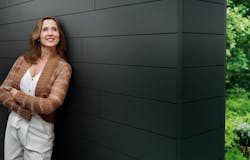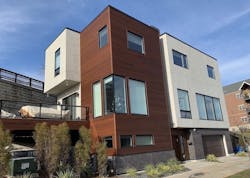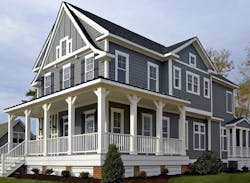Manufacturer Innovation Means Plenty of Siding Options for Builders
This is possibly the golden age for the siding products category. As the building industry sees explosive growth in demand for homes, it also is seeing a steady flow of new home siding options come on the market promising a combination of low maintenance and good looks.
Today there are a range of new product categories emerging, such as polymer/fly-ash siding from Boral TruExterior, ceramic cladding from Daltile, and synthetic split shake siding from DaVinci Roofscapes, among others. Even old standbys, such as wood and vinyl, are offering improved and updated options.
Home Siding Options for Modern Looks
As modern looks trend upward, more brands are promoting panelized systems for siding for homes, bringing a commercial look to the residential marketplace, as well as smooth lap siding to suit the popular modern farmhouse aesthetic. At the 2019 International Builders’ Show, LP Building Solutions expanded its portfolio of engineered wood siding products to include SmartSide Smooth.
“For the past several years, our customers have been asking for a solution that provides the durability of LP SmartSide with a smooth aesthetic,” said Derek Blank, LP’s senior brand manager for LP SmartSide, at the time of the product’s release. “We are thrilled to be launching just that. Our new LP SmartSide Smooth Trim & Siding leverages our durable strand technology, now in a smooth finish.”
As more modern looks trend upward, more brands are promoting panelized systems that bring a commercial look to the residential marketplace and smooth lap siding to suit the popular modern farmhouse aesthetic.
Smooth siding products also are trending with fiber-cement manufacturers, such as Allura and James Hardie Building Products. Back in 2017, Hardie launched the Aspyre Collection, which brings together the modern design of its Reveal Panel System with the traditional profiles of its Artisan Siding. The goal: to provide a combination of products in the collection that helps architects and builders achieve a design vision across the spectrum of architectural styles, from traditional to contemporary and modern.
“James Hardie will always be about pushing the envelope, in terms of new ways to think about—and design with—our products,” Sean Gadd, the company’s chief marketing officer, said at the time of the introduction. “The Aspyre Collection perfectly reflects the James Hardie tradition of not just responding to market trends, but inspiring them.”
Siding That Offers the Best of Both Worlds
When it comes to siding options, some brands offer builders the best of both worlds in one product, such as Boral Building Products’ reversible Shiplap-Nickel Gap siding profile in its TruExterior poly-ash siding and trim line, enabling builders to install the new profile with either a smooth or wood-grain side exposed. A rabbeted edge ensures panels fit together perfectly to create authentic spacing.
Previously, contractors could select TruExterior profiles in non-reversible smooth or wood-grain Shiplap and in smooth Nickel Gap. In combination with four widths and two standard lengths, the reversible format offers a total of 16 possible profile combinations. This means dealers can stock fewer SKUs, while builders can design more varied streetscapes with a single panel.
“Our new reversible Shiplap-Nickel Gap profile makes it easy for builders and remodelers to create beautiful, on-trend exteriors that are both eye-catching and high performing, for a look that truly stands the test of time,” Boral brand manager Ben Drury said at the product’s release.
RELATED
- Do This to Ensure Fiber-Cement Siding Is Trouble-Free
- Siding Options: How to Choose the Right Siding for Your Home
- One-Coat Stucco Basics—6 Common Problem Areas
Tackling the Downsides of Wood Siding
TruExterior, like many home siding products on the market, is designed to emulate the look of painted wood, once the dominant siding material in the U.S. Wood hit its peak market share—44%—in 1981 and 1982, but those numbers decreased drastically as homebuyers developed a distaste for the maintenance and rot often associated with the material. A new generation of wood products hopes to address those issues.
Wood products from companies such as Thermory USA, which offers a heat-treated product, or modified wood products from Lignia and Kebony, promise updated and enhanced performance attributes.
Thermory says its ash, pine, and spruce products undergo a heat-treatment process that modifies each board to the core, “leading to unequaled durability and stability without sacrificing the natural qualities of real wood.” Thermory promises 20 to 25-plus years of rot resistance.
Lignia offers a 50-year warranty against rot and fungal decay in above-ground applications for its modified wood cladding, while Kebony offers a 30-year warranty against rot for above ground contact use.
Home Exterior Traditions Hold Fast
However, based on 2019 U.S. Census Bureau data, it seems that, despite the innovation and breadth of new products, the usual suspects are still kings of the cladding hill. Overall, Census data show the breakdown for primary exterior wall materials used on new single-family homes as:
- Stucco 27%
- Vinyl (including vinyl-covered aluminum) 25%
- Fiber cement 21%
- Brick or brick veneer 20%
- Wood or wood products 5%
- Stone, rock, other stone materials 1%
- Other 1%
While regionally, certain materials—for example, vinyl in the Northeast and stucco in the Pacific, Mountain, and South Atlantic regions—continue to dominate their markets, overall, stucco and fiber cement have seen steady growth during the past 10 years, with vinyl losing its 25-year lead for newly constructed homes, Census data indicate.
MORE INFO: Trends in Exterior Cladding
10 New Home Siding Products You Should Know About
Vinyl siding to withstand the elements
According to Cornerstone Building Brands, its Mastic Western Extreme siding is the only vinyl product designed and engineered to take wild western weather and provide a solution for homeowners that addresses longevity and maintenance concerns. Specially designed panels feature next-generation polymer technology to protect homes from the punishing effects of damaging infrared light, low humidity, and rapid temperature changes found in the intermountain west. Planks have a wood-grain texture and specially formulated pigments to protect new, rich colors against high heat.
Composite cedar-look shakes
Composite roofing manufacturer DaVinci Roofscapes has developed a new line of home siding using the same technology as it uses in its roofing products. Hand-Split Shake Siding mimics the look of cedar shakes but won’t curl, cup, or split like real cedar, the company says. The siding is made from a combination of resins, UV and thermal stabilizers, and a fire retardant material, enabling it to resist impact, fire, mold, algae, insects, salt air, and high winds. Available in eight colors, color is consistent throughout the body of each piece, and the shakes don’t require painting. Tiles measure 18 inches tall, 5/8 inch thick, and come in 8- or 10-inch widths. The 10-inch-wide pieces have a simulated keyway to give the appearance of 4- and 6-inch wide shakes placed together to create a multi-width look.
Smooth and wood-grain looks in one
By adding a reversible Shiplap-Nickel Gap siding profile to its TruExterior line of poly-ash siding and trim, Boral Building Products makes it easy for builders and remodelers to create beautiful, on-trend exteriors that are both eye-catching and high performing, the company says. Two formats are available: smooth Nickel Gap on one side and wood-grain Shiplap on the other, or wood-grain Nickel Gap on one side and smooth Shiplap on the other. The siding comes in 4-, 6-, 8-, and 10-inch widths and in 12- and 16-foot lengths.
High-pressure laminate siding
Trespa has expanded its Pura NFC range of exterior surfacing for residential and low-rise multifamily buildings with two dark matte colors in its Lumen collection—Metropolis Black and New York Grey. Pura NFC is a line of engineered high-pressure laminate panels made from wood-based fibers, kraft paper, and phenolic resins. Ideal for exterior cladding, the product also can be used for decorative façades and interior surfaces. Lumen’s properties allow natural light to be dispersed across a matte surface creating a soft illumination across a saturated color finish, the manufacturer says.
Sustainable softwood siding
Lignia is FSC-certified softwood that has been modified to create a high-performance product ideal for siding applications, the company says. The modification process creates a timber product with very little movement but with all of the properties of hardwoods. It has a 50-year minimum rot and fungal decay warranty in above-ground applications and offers some protection from termites.
Fiber-cement siding for extremes
Allura says its fiber-cement siding products use an advanced formula ideal for even the most extreme climates. Fire-, moisture-, and weather-resistant, the products are available as smooth boards or with a deep, realistic wood-grain texture in a choice of 30 pre-painted colors that offer protection from the elements. Boards come in 12-foot lengths.
Smooth-finish engineered wood siding
LP has updated its SmartSide engineered wood siding with a smooth-finish option that has the look of traditional painted wood. The engineered wood product is treated using a process that helps the products resist termites and fungal decay for long-term strength and durability in a variety of weather conditions, the company says. It comes with a 5/50-year limited warranty.
Modified wood siding
Kebony U.S. siding is a modified wood product that doesn’t require any maintenance aside from basic cleaning, the company says. Developed in Norway, sustainable softwood undergoes a patented environmentally friendly process that involves a combination of infusing a bio-based liquid (a plant-derived waste product called furfuryl alcohol) into the wood and exposing the material to heat in excess of 100°C, which permanently thickens the wood’s cell walls, enhancing its properties. The process gives the product premium hardwood characteristics and a rich brown color throughout.
Polymer shakes and shingles
CertainTeed has developed the next generation of one of its most popular polymer siding products, Cedar Impressions. The line’s double 7-inch 3G Straight Edge Perfection Shingles and accent panels now come in a variety of new colors and shapes. They install like real cedar shingles, project 1 inch, and are available in 22 colors.
Fiber-cement luxury siding and panel system
Aspyre by James Hardie Building Products is a luxury collection of fiber-cement siding that combines two product lines, which can be used individually or in combination, to provide industry professionals with unlimited design possibilities, the company says. James Hardie paired the thick, distinctive profiles of its Artisan siding with the smooth, geometric Reveal Panel System. This allows architects and builders to create high-performing designs that range from traditional to ultra-modern in a wide variety of colors and designs.










